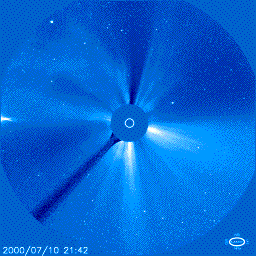 |
www.moonlandings.co.uk
Coronal Ejections
Coronal Ejections
The following animation (382KB) shows geomagnetic unrest as a result of a coronal mass ejection on 10 July 2000 that sent electrically charged gas hurtling toward Earth. Material from a second coronal mass ejection on 11 July was expected to arrive in the neighbourhood of Earth on 14 July. High geomagnetic activity was then expected to persist for another 48 hours (as reported by NASA Space Weather 13.07.00). Mid-2000 saw a peak of electomagnetic activity due to the 11-year reversal of solar polarity (see below)

 The solar magnetic field evolves over the solar cycle along with the sunspot number. Driven by the motions of the ionised gases beneath the visible surface, the North and South poles of the solar magnetic field reverse approximately every eleven years around sunspot number maximum. As a result, there is a roughly 22-year cycle in the Sun's magnetic 'polarity', with the North or South magnetic pole in the northern hemisphere of the Sun during alternate sunspot maxima. The field is more complicated at solar maximum when the simple solar minimum structure, which resembles Earth's field or that of a bar magnet, is disrupted by the strong fields of many active regions. The solar magnetic field evolves over the solar cycle along with the sunspot number. Driven by the motions of the ionised gases beneath the visible surface, the North and South poles of the solar magnetic field reverse approximately every eleven years around sunspot number maximum. As a result, there is a roughly 22-year cycle in the Sun's magnetic 'polarity', with the North or South magnetic pole in the northern hemisphere of the Sun during alternate sunspot maxima. The field is more complicated at solar maximum when the simple solar minimum structure, which resembles Earth's field or that of a bar magnet, is disrupted by the strong fields of many active regions.
|
 |
